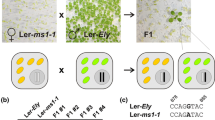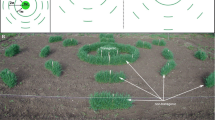Abstract
It has been claimed that engineering traits into the chloroplast will prevent transgene transmission by pollen, precluding transgene flow from crops. A Setaria italica (foxtail or birdseed millet) with chloroplast-inherited atrazine resistance (bearing a nuclear dominant red-leaf base marker) was crossed with five male-sterile yellow- or green-leafed herbicide susceptible lines. Chloroplast-inherited resistance was consistently pollen transmitted at a 3×10−4 frequency in >780,000 hybrid offspring. The nuclear marker segregated in the F2, but resistance did not segregate, as expected. Pollen transmission of plastome traits can only be detected using both large samples and selectable genetic markers. The risk of pollen transmission at this frequency would be several orders of magnitude greater than spontaneous nuclear-genome mutation-rates. Chloroplast transformation may be an unacceptable means of preventing transgene outflow, unless stacked with additional mechanisms such as mitigating genes and/or male sterility.

Similar content being viewed by others
References
Al-Ahmad HI, Galili S, Gressel J (2003) Tandem constructs mitigate risks of transgene flow from crops: tobacco a model (submitted)
Avni A, Edelman M (1991) Direct selection for paternal inheritance of chloroplasts in sexual progeny of Nicotiana. Mol Gen Genet 225:273–277
Birky CW (1995) Uniparental inheritance of mitochondrial and chloroplast genes—mechanisms and evolution. Proc Natl Acad Sci USA, 92:11331–11338
Bock R (2001) Transgenic chloroplasts in basic research and plant biotechnology. J Mol Biol 312:425–438
Bogorad L (2000) Engineering chloroplasts: an alternative site for foreign genes, proteins, reactions and products. Trends Biotech 18:257–263
Chat J, Chalak L, Petit RJ (1999) Strict paternal inheritance of chloroplast DNA and maternal inheritance of mitochondrial DNA in intraspecific crosses of kiwifruit. Theor Appl Genet 99:314–322
Corriveau JP, Coleman AW (1988) Rapid screening method to detect potential biparental inheritance of plastid DNA and results for over 200 angiosperm species. Am J Bot 75:1443–1458
Daniell H (2002) Molecular strategies for gene containment in transgenic crops. Nature Biotech 20:581–586
Darmency H (1994) Genetics of herbicide resistance in weeds and crops. In: Powles SB and Holtum JAM (eds) Herbicide resistance in plants: biology and biochemistry. Lewis, Boca-Raton, pp 263–298
Darmency H, Pernes J (1985) Use of wild Setaria viridis (L.) Beauv. to improve triazine resistance in cultivated S. italica L. by hybridization. Weed Res 25:175–179
Derepas A, Dulieu H (1992) Inheritance of the capacity to transfer plastids by the pollen parent in Petunia hybrida. J Hered 83:6–10
Diers L (1971) Übertragung von Plastiden durch den Pollen bei Antirrhinum majus. II. Der Einfluß verschiedener Temperaturen auf die Zahl des Schecken. Mol Gen Genet 113:150–153
Frey JE, Muller-Scharer H, Frey B, Frei D (1999) Complex relation between triazine-susceptible phenotype and genotype in the weed Senecio vulgaris may be caused by chloroplast DNA polymorphism. Theor Appl Genet 99:578–586
Gawronski SW (1985) Inheritance of resistance to triazine herbicides by Echinochloa crus-galli. Proc 5th Int Congress of the Society for the Advancement of Breeding Research in Asia and Oceania (Bangkok), pp 797–801
Gressel J (1999) Tandem constructs: preventing the rise of superweeds. Trends Biotechnol 17:361–366
Gressel J (2002) Molecular biology of weed control. Taylor and Francis, London
Hagemann R (1992) Plastid genetics in higher plants. In: Hermann RG (ed) Cell organelles. Springer, Berlin, pp 65–96
Hagemann R, Schroeder M (1989) The cytological basis of plastid inheritance in angiosperms. Protoplasma 152:57–64
Heap IM (2003) International survey of herbicide-resistant weeds. http://www.weedresearch.com
Holm LG, Plucknett JD, Pancho LV, Herberger JP (1977) The world's worst weeds, distribution and biology, University Hawaii Press, Honolulu
Hu HK, Ma SH, Shi YH (1986) The discovery of a male-sterile gene in millet (Setaria italica). Acta Agron Sin 12:73–78
Huang CY, Ayliffe MA, Timmis JN (2003) Direct measurement of the transfer rate of chloroplast DNA into the nucleus. Nature 422:72–76
Kiang A-S, Connolly V, McConnell DJ, Kavavagh TA (1994) Paternal inheritance of mitochondria and chloroplasts in Festuca pratensis-Lolium perenne intergeneric hybrids. Theor Appl Genet 87:681–688
Maliga P (2002) Engineering the plastid genome of higher plants. Curr Opin Biotech 5:164–172
Mogensen HL (1996) The hows and whys of cytoplasmic inheritance in seed plants. Am J Bot 83:383–404
Mogensen H, Rusche M (2000) Occurrence of plastids in rye (Poaceae) sperm cells. Am J Bot 87:1189–1192
Reboud X, Zeyl C (1994) Organelle inheritance in plants. Heredity 72:132–140
Shiraishi S, Maeda H, Toda T, Seido K, Sasaki Y (2001) Incomplete paternal inheritance of chloroplast DNA recognized in Chamaecyparis obtusa using an intraspecific polymorphism of the trnD-trnY intergenic spacer region. Theor Appl Genet 102:935–941
Souza-Machado V (1982) Inheritance and breeding potential of triazine tolerance and resistance in plants. In: LeBaron HM, Gressel J (eds) Herbicide resistance in plants. Wiley, New York, pp 257–273
Tilney-Bassett RAE, Abdel-Wahab OAL (1979) Maternal effects and plastid inheritance. In: Newth DR, Balls M (eds) Maternal effects in development. Cambridge University Press, Cambridge, pp 29–45
Wang T, Du R (1994) Application of highly male-sterile gene of foxtail millet to routine breeding. Acta Agric Boreali-Sin 9:21–25
Wang T, Chen HB, Reboud X, Darmency H (1997) Pollen-mediated gene flow in an autogamous crop: Foxtail millet (Setaria italica). Plant Breed 116:579–583
Wang T, Xin Z, Shi Y, Darmency H (2000) A creation, evaluation and utilization of the new crop germplasm: herbicide resistant foxtail millet (Setaria italica) (in Chinese). Rev China Agric Sci Tech 2:62–66
Zhao Z, Cui W, Du G, Yang S (1996) The selection of millet photo(thermo)-sensitive line 821 and a study on the relation of sterility to illumination and temperature. Sci Agric Sin 29:23–31
Acknowledgements
Prof. Z. Zhao provided some of the strains used, and Y. Wang, Y. Zhang and Y. Song gave excellent technical assistance. This research was supported by EU-INCO project grant ERB IC18 CT98 0391 the National Gongguan Plan of China 2001BA511B04 and the Gilbert de Botton chair of Plant Sciences (to JG).
Author information
Authors and Affiliations
Corresponding author
Additional information
Communicated by R. Hagemann
Rights and permissions
About this article
Cite this article
Wang, T., Li, Y., Shi, Y. et al. Low frequency transmission of a plastid-encoded trait in Setaria italica . Theor Appl Genet 108, 315–320 (2004). https://doi.org/10.1007/s00122-003-1424-8
Received:
Accepted:
Published:
Issue Date:
DOI: https://doi.org/10.1007/s00122-003-1424-8




